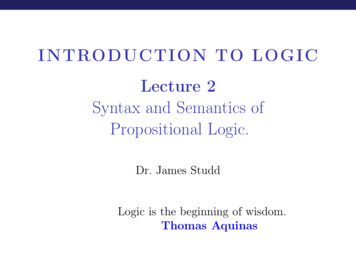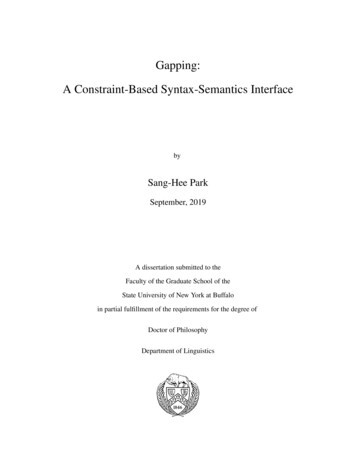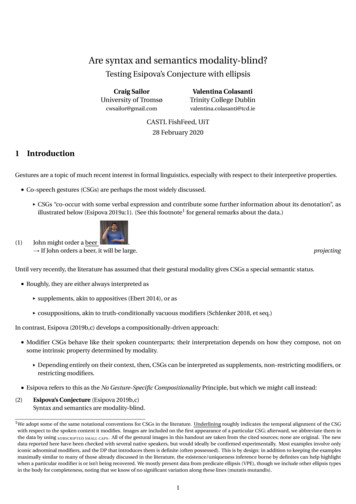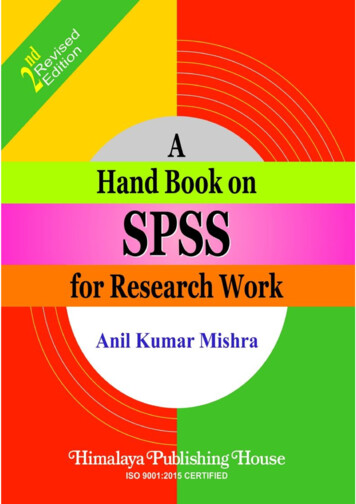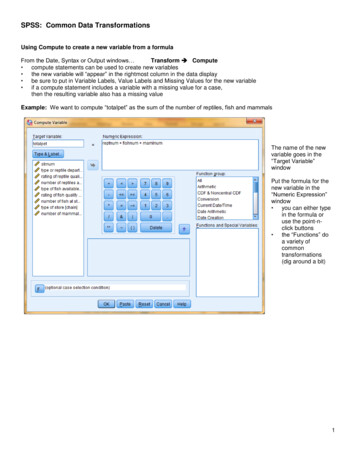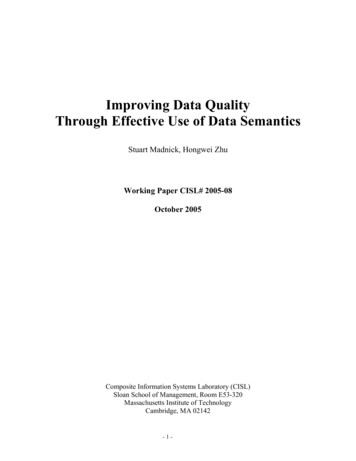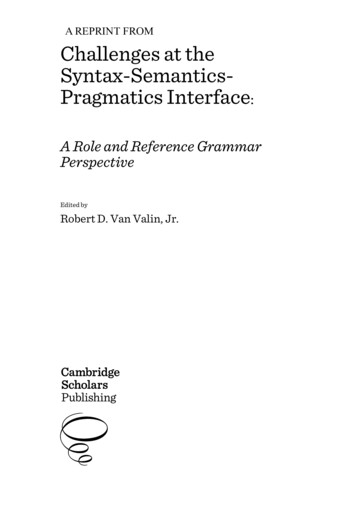
Transcription
A REPRINT FROMChallenges at theSyntax-SemanticsPragmatics Interface:A Role and Reference GrammarPerspectiveEdited byRobert D. Van Valin, Jr.
Challenges at the Syntax-Semantics-Pragmatics Interface:A Role and Reference Grammar PerspectiveEdited by Robert D. Van Valin, Jr.This book first published 2021Cambridge Scholars PublishingLady Stephenson Library, Newcastle upon Tyne, NE6 2PA, UKBritish Library Cataloguing in Publication DataA catalogue record for this book is available from the British LibraryCopyright 2021 by Robert D. Van Valin, Jr. and contributorsAll rights for this book reserved. No part of this book may be reproduced,stored in a retrieval system, or transmitted, in any form or by any means,electronic, mechanical, photocopying, recording or otherwise, withoutthe prior permission of the copyright owner.ISBN (10): 1-5275-6747-8ISBN (13): 978-1-5275-6747-4
COSUBORDINATIONROBERT D. VAN VALIN, JR.UNIVERSITY AT BUFFALO, THE STATE UNIVERSITYOF NEW YORKHEINRICH HEINE UNIVERSITY DÜSSELDORFAbstractThe theory of clause linkage in Role and Reference Grammar [RRG] is oneof the most important and distinctive aspects of the theory. One of its significant features is the positing of a third syntactic linkage type, cosubordination, in addition to the two traditional linkage types, coordination andsubordination, which has been widely adopted in the typological literatureand used in many descriptive grammars. Nevertheless, its validity as a distinct linkage type has been questioned in Foley (2010) and Bickel (2010).The purpose of this paper is to evaluate their arguments and show thatcosubordination is a valid concept, albeit more complex than originallysupposed.KeywordsClause linkage, nexus, embedding, juncture, information structure1. IntroductionThe theory of clause linkage in Role and Reference Grammar [RRG] isone of the most important and distinctive aspects of the theory. One of itsmost significant features is the positing of a third syntactic linkage type,cosubordination, in addition to the two traditional linkage types, coordination and subordination. While this notion has been widely adopted in thetypological literature and used in many descriptive grammars, it has beencriticized in Foley (2010) and Bickel (2010), who questioned its validity asa distinct linkage type. The purpose of this paper is to evaluate their arguments and argue that cosubordination is a valid concept, albeit morecomplex that originally supposed.
242CosubordinationThe discussion will proceed as follows. In section 2 there will be abrief review of the theory of clause linkage in RRG, followed in section 3by a summary of Foley and Bickel’s criticisms of the notion of cosubordination. In section 4 their arguments will be subjected to critical evaluation, and it will be argued that they are not a problem for the contemporarytheory of clause linkage in RRG. Section 5 gives a summary and conclusions.2. The RRG theory of clause linkage: a review 1The RRG theory of complex sentences has three main components: thelayered structure of the clause [LSC], which supplies the units which arecombined in complex sentences; the three syntactic linkage relations (coordination, subordination, cosubordination), which characterize the syntactic relationship between the units; and the interclausal semantic relationshierarchy, which deals with the semantic relationship between the units.Only the first two are relevant to this discussion. The units of clause structure (the nucleus, the core and the clause) define the levels of juncture: nuclear junctures involve the linking of nuclei, as in (1a,b), core junctures thelinking of cores, as in (2a,b), and clausal junctures the linking of wholeclauses, as in (3). 2yī ge fànwǎn.(1) a. Tā [N qiāo] [N pò] le3sg hit break PRFV one CL ricebowl‘He broke (by hitting) a ricebowl.’b. Fu fase [N fi] [N isoe].3sg letter sit write‘He sat writing a letter.’Mandarin Chinese(Hansell 1993)Barai (Olson 1981)[Papua-New Guinea]For detailed discussion of the RRG theory of juncture-nexus types, see Van Valin& LaPolla (1997), chapter 8, and Van Valin (2005), chapter 6.2 Abbreviations: AFD ‘actual focus domain’, ASP ‘aspect’, ASS ‘assertion’, C‘core’, Cl ‘clause’, CL ‘classifier’, CLM ‘clause-linkage marker’, CMPL ‘completive’, CONT ‘continuative’, CUR.REL ‘current relevance, dl ‘dual’, DS ‘differentsubject’, DIR ‘directional’, DUR ‘durative’, EVID ‘evidential’, FUT ‘future’, IF‘illocutionary force’, IND ‘indicative’, IPFV ‘imperfective’, LOC ‘locative’, LSC‘layered structure of the clause’, NEG ‘negation’, NPST ‘non-past’, ns ‘nonsingular’, N, NUC ‘nucleus’, POSS ‘possessor’, PRED ‘predicate’, PRES ‘present’, PRFV ‘perfective’, PRO ‘pronoun’, Q ‘question’, RP ‘reference phrase’,SEQ ‘sequential’, SIM ‘simultaneous’, SS ‘same subject’, STA ‘status’, TNS‘tense’, TPAST ‘today’s past’, TRANS ‘transitive’, YPAST ‘yesterday’s past’.1
Robert D. Van Valin, Jr.243(2) a. [C Max tried][C to fix his bicycle].b. [C Max regrets [C asking Bill about it]].(3)[Cl Mary bought fresh fish at the market] and [Cl John will cook it].The second relevant component is the syntactic relationship betweenthe units, or nexus relation. The example in (3) exemplifies (clausal) coordination, and the one in (2b) illustrates a type of (core) subordination, inwhich one core (asking Bill about it) functions as a core argument of another core (Max regrets). Cosubordination, as the name implies, has features of both coordination and subordination. It is like coordination andunlike subordination, in that it is a flat structure (no embedding), but it islike subordination and unlike coordination in that the linked unit is dependent on the matrix (or ‘licensing’) unit in some way. In cosubordination the dependence concerns operators at the level of juncture. The contrast among the three nexus types at the clause level can be seen clearly inthe following examples from Amele (Roberts 1988).(4) a. Fred cumho-i-anqa Bill uqadec h-ugi-an.tomorrow come-3sg-FUTyesterday come-3sg-YPAST but‘Fred came yesterday, but Bill will come tomorrow.’b. Ija ja hud-ig-aeu nu, uqa sab mane-i-a.1sg fire open-1sg-TPAST that for 3sg food roast-3sg- TPAST‘Because I lit the fire, she cooked the food.’c. Ho busale-ce-bdana age qo-ig-a.pig run.out-DS-3sg man 3pl hit-3pl- TPAST‘The pig ran out and the men killed it.’In (4a) classic coordination at the clause level is exemplified: each clauseis fully inflected and could stand on its own as an independent utterance.In (4b) each clause is fully inflected, but the first clause is marked by asubordinating conjunction, which makes it structurally dependent on themain clause; it cannot stand on its own as an independent utterance. Thisis a clear example of (adverbial) subordination. In (4c) the first clauselacks tense marking and therefore is dependent on the second clause forthe expression of tense. Accordingly, the first clause cannot stand on itsown as an independent utterance. Moreover, it is neither an adverbialmodifier of the second clause, nor is it an argument (complement) of theverb in the second clause, which rules out an analysis of it as subordination. However, it is clearly different from the coordination example in(4a) as well, and so it does not fit into either of the traditional categories; it
244Cosubordinationis, then, an instance of cosubordination at the clause level. It is importantto note that while the first clause in (4c) is dependent on the second for theexpression of tense, it is not embedded in it, unlike the adverbial subordinate clause in (4b) or the gerund in (2b). Thus, a crucial idea underlyingthe RRG theory of clause linkage is that dependent does not entail embedded; there can be formal dependencies between units in a flat structure.The three nexus types can occur in nuclear, core and clausal junctures,generating nine possible juncture-nexus relations. Cosubordination at thenuclear level is illustrated in (1a), in which two nuclei, qiāo ‘hit’ and pò‘break’, form a single complex nucleus under the scope of the le perfectiveaspect operator, aspect being a nuclear operator. Cosubordination at thecore level is exemplified in (2a), which can be seen clearly when a deonticmodal operator, a core operator, is added, as in (5a).(5) a. Max must try to fix his bicycle.b. Max must persuade Bill to fix his bicycle.What Max is obliged to do in (5a) is not to try anything but rather to try tofix his bicycle, which means that the scope of must is over both cores. Incontrast, in (5b) Max is obliged to persuade Bill of something, but Bill isnot obliged to fix his bicycle, which means that must has scope over onlythe first core but not the second; hence (5b) is not an example of corecosubordination but rather of core coordination. 3 Thus the structures in(5a, b) do not involve embedding, hence they are not examples of subordination, contra the conventional wisdom regarding these constructions (seeVan Valin 2005:189-90 for evidence against an embedding analysis).3. Critiques of cosubordinationFoley (2010) and Bickel (2010) attempt to call into question the validity ofthe notion of cosubordination. They restrict their arguments to clausalcosubordination only, and Foley assumes the original version of the LSCpresented in Foley & Van Valin (1984), which differs in certain crucialrespects from the version developed in Van Valin (1993b) and subsequentwork. The notion of the LSC at that time was rather different from theIt’s important to emphasize here that ‘coordination’ is an abstract linkage relationand not a grammatical construction; it should be distinguished from ‘conjunction’,which is a formal construction type. Coordination may be instantiated by conjunction, as in (3), but it is not restricted to cases of formal conjunction.3
Robert D. Van Valin, Jr.245concept that is assumed today; it is presented in Figure 1.(IF(EVID(TNS(STA[Loc,.(MOD[NP (NP) (DIR(ASP[Predicate]))])]))))PERIPHERY CORENUCLEUSFigure 1: The LSC in Foley & Van Valin (1984:224)As can be clearly seen, there is no ‘clause’ or ‘sentence’ level, and theperiphery surrounds the core and nucleus. The shift to the currentconception of the LSC began with Van Valin (1987) and was firstpublished in Van Valin (1990, 1993b).There was no formalrepresentation of the LSC, and in particular the projection grammarformalism had not yet been developed; it was proposed in Johnson (1987)and ushered in the representation of constituents, operators andinformation structure in distinct projections, also first published in VanValin (1993b). Furthermore, in the 1984 book there was no representationof complex sentences beyond labeled bracketings, which did not includeany representation of operators.Their criticisms center on two key issues: first, there seem to be casesin which the scope of clausal operators is variable, as in (6) from Tauya(Papua New Guinea), and second, there are cases in which not all clausaloperators are shared across the clauses, as in (7a) from Wambule (SinoTibetan) and (7b) from Korafe (Papua New Guinea).(6)Tepau-fe-payate fitau-a-nae?Tauya (MacDonald 1990)break-TRANS-SS go throw-2-Qa. ‘Did you break it and go away?’, orb. ‘You broke it and did you go away?’, orc. ‘Did you break it before going away?’(7) a. Wambule (Opgenort 2004)[Sino-Tibetan; cited in Bickel (2010:67)]Nahep ja:-ma-ktyaŋiskul di-ŋ-m.previously grain eat.1sg-PAST-SEQ from.now school move-1sg-ASS‘I ate cooked grain before, and now I will go to school.’b. Korafe (Farr 1999) [Papua New Guinea; cited in Bickel DS IPFV-go.DUR.PRES.3sgIND-CUR.REL‘I gave it, and he is currently going.’The problem that both Foley and Bickel see in (6) is the apparently variable scope of the illocutionary force operator: it seems to have scope over
246Cosubordinationboth clauses, yielding the reading in (6a), or only over the second clause,yielding the interpretation in (6b), or only over the first clause, yielding(6c). They interpret this as evidence against the notion of cosubordination,because it involves obligatory sharing of operators at the level of juncture,and here the operator sharing is variable and optional. The structure wouldbe cosubordination on the (6a) reading but not on the (6b) or (6c) interpretations. Foley argues further that the examples in (7) are problematic, because not all clausal operators are shared across the two clauses: in (7a)there is one illocutionary force operator on the second clause, but the tenseoperator in the first clause has scope only over it, and the second clausegets a non-past interpretation; in (7b) there is again a single illocutionaryforce operator, but the first clause is interpreted as past tense, due to thesequential-realis affix, while the second clause is marked for present tense.As noted above, Foley assumes the model of clause structure and thenotion of cosubordination presented in Foley & Van Valin (1984), ignoring all subsequent work. In the 1984 version of the theory, no formalismof any kind had been developed, and in the informal representations usedat that time, operator sharing was all or nothing. His proposed solutionexploits an idiosyncratic feature of Lexical-Functional Grammar [LFG],namely the distinction between IP and S, where ‘IP’ contains grammaticalcategories like tense and illocutionary force and ‘S’ is a ‘small clause’containing the predicate and its arguments. He claims that the contrast between coordination in e.g. (4a) and cosubordination in e.g. (4c) is a function of what is linked, not a difference in linkage relations. Hence there iscoordination in (4a) between IPs but in (4c) between Ss. According to thisanalysis, what RRG calls ‘cosubordination’ is just coordination of Ss under one or more IP nodes, each reflecting a different grammatical category,and therefore cosubordination is not a distinct linkage type.This alternative analysis of the phenomena which motivate the postulation of cosubordination does not call the notion of cosubordination intoquestion. To begin with, its is limited to clause-level linkages; it does notapply to cosubordination at the core level, as in (2a), or at the nuclear level, as in (1a,b). 4 One would have to postulate something like a VP-level IPand a V-level IP in order to deal with these examples, and that is not anoption in LFG. The result is a situation in which cosubordination is a linkage relation at sub-clausal levels but the analogous phenomena at theclause-level are handled in terms of a special type of coordination involvSee Bohnemeyer & Van Valin (2017) for discussion of the importance of cosubordination in core junctures in relation to the Macro-Event Property.4
Robert D. Van Valin, Jr.247ing Ss instead of IPs. It is difficult to see why this is an improvement overan analysis in which operator-sharing constructions are given a unifiedtreatment at the clause level as well as sub-clausal levels.Bickel (2010) starts out by saying that categories like ‘coordination’,‘subordination’ and ‘cosubordination’ are too broad and not fine-grainedenough to capture the diversity found in clause-linkage constructions. Hedecomposes the different constructions into a set of 11 features, each witha range of values. For example, ‘T[ense]-mark[ing]’ in dependent clauseshas the values: OK (allowed), Banned (not allowed), Harmonic (allowedbut subject to constraints based on the tense or status choice in the mainclause). He then performs a statistical analysis to see if the features clusterinto well-defined categories like coordination, subordination and cosubordination. He argues that this is not the case: there is tentative evidence fora specific prototype of subordination, but none for coordination andcosubordination, which seem to form a continuum. Given that coordination and cosubordination share the crucial feature of being a flat, i.e. nonembedded, structure, it appears that Bickel’s results reflect the salience ofembedding as a feature of complex sentences. This is an interesting result,as there has been some debate within RRG as to which of the two definingfeatures of nexus, [ dependent] and [ embedded], is more basic. VanValin (1993b) proposed that [ embedded] is the more basic feature, setting subordination off from coordination and cosubordination, which arethen distinguished by [ dependent]. In Van Valin & LaPolla (1997), onthe other hand, [ dependent] was taken as the basic distinction, with coordination being [– dependent] and the other two bring [ dependent];subordination and cosubordination were then differentiated by [ embedded]. Bickel’s results support the 1993 analysis, not the 1997 one. This issummarized in Figure 2.Figure 2: Nexus typesBickel’s results can, thus, be seen as evidence of the significance of embedding in the structure of complex sentences and not as evidence againstthe validity of the notion of cosubordination.
248Cosubordination4. Re-examining cosubordinationCosubordination was first proposed as a linkage type in Olson (1981), andit was further developed in Foley & Van Valin (1984). As noted above, itwas assumed at that time that all of the operators at a given level of theclause must be shared in cosubordination, and that is the case in all of theexamples presented in Foley & Van Valin (1984). Foley (2010:29) explicitly states that all operators must be shared.In the decade after the publication of Foley & Van Valin (1984), however, work on complex sentences in a variety of languages, e.g. MandarinChinese (Tao 1986, Hansell 1993), Nootka (Jacobsen 1993), Japanese(Hasegawa 1992, 1996), and Turkish (Watters 1993), made clear that notall operators must be shared at the level of juncture. Rather, at least onemust be shared, and the more that are shared, the tighter the link betweenthe units. “[I]n a cosubordinate linkage at a given level of juncture, thelinked units are dependent upon the matrix unit for expression of one ormore of the operators for that level.”(Van Valin 1993b:112; see also VanValin & LaPolla 1997:455, Van Valin 2005:201) In clausal junctures, illocutionary force, the outermost operator, must be shared; other clausaloperators such as status and tense may or may not be shared. This can beseen clearly in the contrast between the Korafe example in (7b) and theAmele example in (8). The Amele example has the structure in Figure 3a;the Korafe sentence has the structure in Figure 3b.(8) Ho busale-ce-bdana age qo-ig-afo? Amele (Roberts 1988)[Papua New Guinea]pig run.out-DS-3sg man 3pl hit-3pl-TPAST Q‘Did the pig run out and did the men kill it?’(*‘The pig ran out and did the men kill it?)
Robert D. Van Valin, Jr.Figure 3a: Structure of (8)249Figure 3b: Structure of (7b)In Amele, both tense and illocutionary force must be shared in clausalcosubordination, and this is explicitly represented by having the operatorsmodify the superordinate clause nodes. The motivation for having ‘duplicate’ clause nodes is that it is necessary to represent the scope of each operator separately, since they may or may not be shared. Korafe is just suchan example: there are three clausal operators (status, tense and illocutionary force), and only illocutionary force is shared, with each clause havingindependent tense and status marking. Such a situation could not be captured in terms of the 1984 version of the LSC in Figure 1, but it can bereadily expressed in terms of the RRG multiple projection representation.In sub-clausal junctures, at least one operator at the level of juncture mustbe shared; which operator that will be depends on the inventory of coreand nuclear operators in the language.
250CosubordinationWhen there is operator sharing in cosubordination, it must be obligatory, and in light of this requirement both Foley and Bickel point to theTauya example in (6) as being extremely problematic for the concept ofcosubordination. At first glance, it does indeed appear to be a counterexample to this requirement, but if we invoke another aspect of the theorynot available in 1984, a solution readily presents itself. Foley himself(2010:47) points to the solution: there is only one IF operator (Figure 4)but the focus vs. presupposition division of the sentence varies (Figures5a-c), which is represented in the focus structure projection in terms of theactual focus domain.Figure 4: Tauya--Structure of (6)Figure 5a: AFD for (6a)
Robert D. Van Valin, Jr.Figure 5b: AFD for (6b)251Figure 5c: AFD for (6c)In Figure 4 the constituent and operator projections are given, showingthat the illocutionary force operator nae ‘interrogative’ has scope overboth clauses. This establishes that the potential focus domain is the entiresentence; it is represented by the dotted black line in the focus structureprojection in Figures 5a-c. What varies is the actual focus domain [AFD],where the focus of the question lies. The reading in (6a), represented inFigure 5a, has both clauses within the AFD, as represented by the grey triangle. The one in (6b), on the other hand, reflects the AFD being limitedto the second clause, the first one being presupposed; this is shown in Figure 5b. The most revealing interpretation is the one in (6c), in which theAFD includes the first clause but not the second, as given in Figure 5c.This reading is crucial evidence in favor of a cosubordination analysis, because if this were a typical coordinate construction, it would be impossiblefor an illocutionary force marker in the second clause to skip over theclause it occurs in and have just the first clause in its scope. 5 Rather, theAFD includes only the first clause, the second one being presupposed, andthe scope of the question operator is the entire sentence. A complete analysis of the Tauya construction involves all three projections of the LSC.Thus, the Tauya example in (6) turns out to be strong evidence in favor ofAs Foley (2010:47) notes, it would be impossible to represent such a situationusing the conjoined Ss under IP analysis.5
252Cosubordinationa cosubordinate analysis and against a coordinate analysis.Another example of variation in operator scope cited by Bickel(2010:61) is given in (9) from Belhare.(9) Kimm-en-ta-ch-uki mun n-dhup-chi.Belharehouse-LOC 3ns-reach-dl-3sg SEQ 3dl 3ns-chat.NPST-dl [Tibetoa. ‘They will reach home and chat,’ orBurman, Nepal]b. ‘When they reach home, they’ll chat,’ orc. ‘They reached home and now they will chat.’Bickel notes “the scope [of the main clause tense marker-RVV] is primarily limited to the main clause, but can optionally be extended into the dependent clause” (2010:61). This seems to be a case of optional rather thanobligatory operator sharing, but it is less of a problem than it appears. Asmentioned earlier, in clausal cosubordination illocutionary force, theoutermost operator at the clause level, must be shared across the units, andthat is the case in (9), which is a statement. Tense may, as in (8), or maynot, as in (7b), be shared, but the construction is still clausal cosubordination, due to the shared illocutionary force. The variation in the interpretation of the tense in (9) parallels the variation in the interpretation of theAFD in (6), and it is tempting to offer a similar analysis. It is, however,difficult to see why the interpretation of tense should be tied to variation inthe AFD, since tense and focus are rather different notions and belong todistinct projections of the clause. What would be problematic would bevariation like this in sub-clausal operators, e.g. variability in the interpretation of the scope of aspect marking in a nuclear juncture like (1a). I amaware of no such examples; this kind of variability seems to be found inclausal junctures only and only with operators other than illocutionaryforce. Accordingly, the revision proposed in Van Valin (2005:205), that insome languages cosubordination is characterized in terms of possible rather than obligatory operator sharing, is unnecessary.5. ConclusionFoley (2010) and Bickel (2010) raise important questions about the validity of the notion of cosubordination as a nexus relation in complex sentences. It has been argued that these questions can be answered satisfactorilywithin the contemporary version of RRG, based on the LSC and the projection grammar representation of it, on the post-1984 conception ofcosubordination, and including the information structure component.Cosubordination has been an integral part of the description of clause link-
Robert D. Van Valin, Jr.253age in numerous languages; in addition to those mentioned earlier, theyinclude Yaqui (Guerrero-Valenzuela 2006), Q’eqchi’ Mayan (Kochelman2003), Chechen (Good 2003), Kwaza (van der Voort 2004), and Kikuyu(Kihara 2017). It remains a valid and valuable concept in the analysis ofcomplex sentences. 6ReferencesBickel, Balthasar. 2010. Capturing particulars and universals in clauselinkage: A multivariate analysis. In Bril, ed., 51-101.Bohnemeyer, Jürgen and Van Valin, Robert. 2017. The Macro-EventProperty and the layered structure of the clause. Studies in Language41:142-197.Bril, Isabelle, ed. 2010. Clause Linking and Clause Hierarchy. Amsterdam: Benjamins.Farr, Cynthia. 1999. The Interface between Syntax and Discourse inKorafe, a Papuan Language of Papua New Guinea. Canberra: PacificLinguistics.Foley, William. 2010. Clause linkage and nexus in Papuan languages. InBril, ed., 27-50.Foley, William & Van Valin, Robert. 1984. Functional Syntax and Universal Grammar. Cambridge: Cambridge University Press.Good, Jeff. 2003. Clause Combining in Chechen. Studies in Language 27:113-170.Guerrero-Valenzuela, Lilián. 2006. The Structure and Function of YaquiComplementation. Studies in Native American Linguistics 54. Munich:Lincom Europa.Hansell, Mark. 1993. Serial verbs and complement constructions in Mandarin: A clause linkage analysis. In Van Valin, ed., 197-233.Hasegawa, Yoko. 1992. Syntax, semantics, and pragmatics of TE-linkage.Berkeley: University of California, Berkeley (PhD dissertation).—. 1996. A Study of Japanese Clause Linkage: The Connective TE in Japanese. Stanford: CSLI.Jacobsen, William H. 1993. Subordination and cosubordination in Nootka:Clause combining in a polysynthetic verb-initial language. In Van VaThis research was supported in part by the German Research Foundation as partof CRC 991 ‘The structure of representations in language, cognition and science’.This paper was presented at the 2015 International Conference on Role and Reference Grammar at the Heinrich Heine University Düsseldorf.6
254Cosubordinationlin, ed., 235-74Johnson, Mark. 1987. A new approach to clause structure in Role and Reference Grammar. Davis Working Papers in Linguistics 2:55-59.Kihara, C. P. 2017. Aspects of Gĩkũyũ (Kikuyu) Complex Sentences: ARole and Reference Grammar Analysis. Düsseldorf: Heinrich HeineUniversity (PhD dissertation).Kochelman, Paul. 2003. The Interclausal Relations Hierarchy in Q'eqchi'Maya. International Journal of American Linguistics 69:25-48.MacDonald, Lorna. 1990. A Grammar of Tauya. Berlin: Mouton de Gruyter.Olson, Michael. 1981. Barai Clause Junctures: Toward a Functional Theory of Interclausal Relations. Canberra: Australian National University (PhD dissertation).Opgenort, Jean. 2004. A Grammar of Wambule. Leiden: Brill.Roberts, John 1988. Amele switch-reference and the theory of grammar.Linguistic Inquiry 19:45-64.Tao, Liang. 1986. Clause linkage and zero anaphora in Mandarin Chinese.Davis Working Papers in Linguistics 1:36-102.van der Voort, Hein. 2004. A Grammar of Kwaza. (Mouton Grammar Library 30). Berlin: Walter de Gruyter.Van Valin, Robert. 1987. Recent developments in Role and ReferenceGrammar: The layered structure of the clause and juncture. (Editor’sintroduction) Davis Working Papers in Linguistics 2:1-5.—. 1990. Layered syntax in Role and Reference Grammar. M. Bolkestein,J. Nuyts and C. Vet (eds.), Layers and Levels of Representation inLanguage Theory: A Functional View, 193-231. Amsterdam: JohnBenjamins.—. ed. 1993a. Advances in Role and Reference Grammar. Amsterdam:Benjamins.—. 1993b. A synopsis of Role and Reference Grammar. In Van Valin, ed.,1-164.—. 2005. Exploring the Syntax-Semantics Interface. Cambridge: Cambridge University Press.Van Valin, Robert & LaPolla, Randy. 1997. Syntax: Structure, Meaning &Function. Cambridge: Cambridge University Press.Watters, James K. 1993. An investigation of Turkish clause linkage. InVan Valin, ed., 535-60.
Challenges at the Syntax-Semantics-Pragmatics Interface: A Role and Reference Grammar Perspective . Publishing . Lady Stephenson Library, Newcastle upon Tyne, NE6 2PA, UK . British Library Cataloguing in Publication Data . A catalogue record for this book is available from the British Library . 1sg fire open-1sg-TPAST that for 3sg food .


